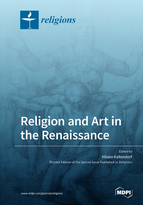Religion and Art in the Renaissance
A special issue of Religions (ISSN 2077-1444). This special issue belongs to the section "Religions and Humanities/Philosophies".
Deadline for manuscript submissions: closed (1 September 2021) | Viewed by 34581
Special Issue Editor
Special Issue Information
Dear Colleagues,
The Issue will focus on intersections of religious faith and artistic production during the Renaissance. Its temporal scope will be 1300–1700, or the Renaissance broadly defined. Its geographical scope will be Europe, or European colonies such as the Americas that participated in Renaissance artistic trends or movements. Its purpose will be to deepen and broaden our understanding of how images impact faith and how in turn faith finds expression in images. The Special Issue will be interdisciplinary in nature, bringing together into one volume some of the most recent work by younger scholars in iconography, art history and religious studies who are employing more current theoretical frameworks than the ones appearing in much of the existing literature.
Dr. Hilaire Kallendorf
Guest Editor
Manuscript Submission Information
Manuscripts should be submitted online at www.mdpi.com by registering and logging in to this website. Once you are registered, click here to go to the submission form. Manuscripts can be submitted until the deadline. All submissions that pass pre-check are peer-reviewed. Accepted papers will be published continuously in the journal (as soon as accepted) and will be listed together on the special issue website. Research articles, review articles as well as short communications are invited. For planned papers, a title and short abstract (about 100 words) can be sent to the Editorial Office for announcement on this website.
Submitted manuscripts should not have been published previously, nor be under consideration for publication elsewhere (except conference proceedings papers). All manuscripts are thoroughly refereed through a double-blind peer-review process. A guide for authors and other relevant information for submission of manuscripts is available on the Instructions for Authors page. Religions is an international peer-reviewed open access monthly journal published by MDPI.
Please visit the Instructions for Authors page before submitting a manuscript. The Article Processing Charge (APC) for publication in this open access journal is 1800 CHF (Swiss Francs). Submitted papers should be well formatted and use good English. Authors may use MDPI's English editing service prior to publication or during author revisions.
Keywords
- art
- religion
- Renaissance
- Spain
- Italy
- politics
- ideology
- conquest






